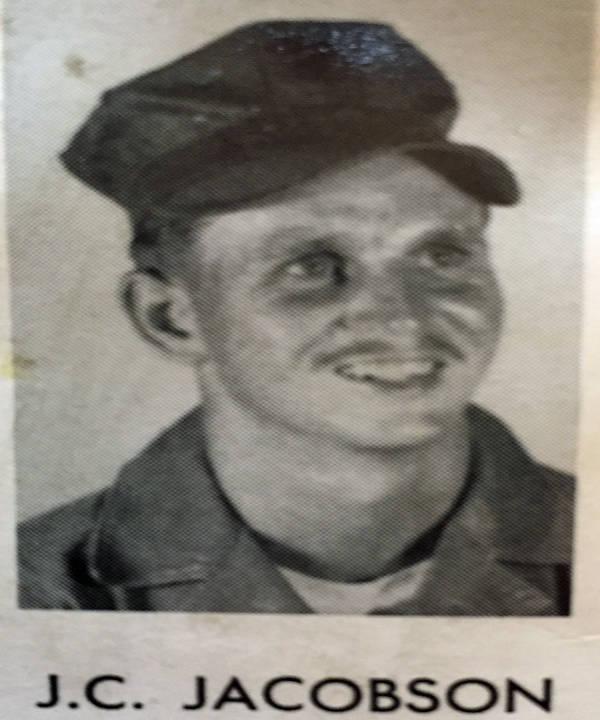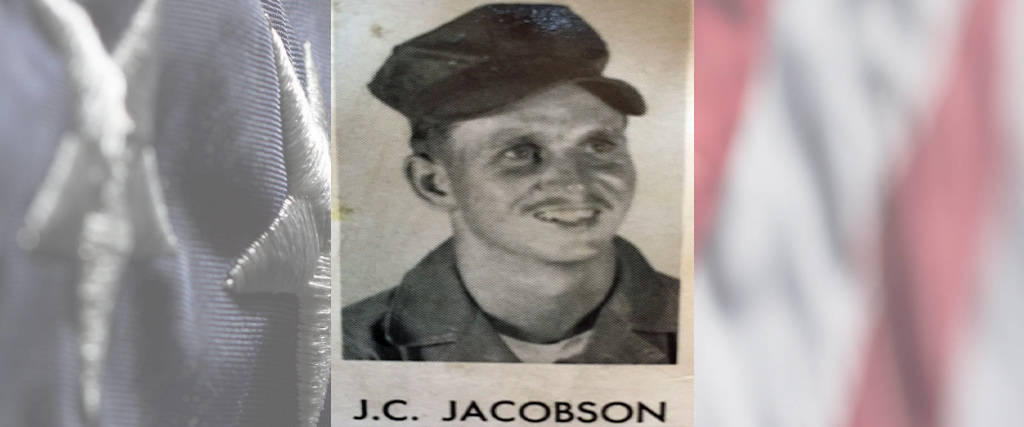U.S. Navy Vietnam Des Plaines, IL Flight date: June, 2019
By Mark Splitstone, Honor Flight Chicago Veteran Interviews Volunteer

John Jacobson was born in Circle Pines, Minnesota, in 1943. Growing up, he had an interest in construction and after graduation from high school he took a job building garages. An uncle of his had been a cook with the Navy Seabees in World War II and John had often talked to him about his experiences. John’s interest in construction combined with his uncle’s stories led him to join the Navy, and specifically the Seabees, in March of 1963.
United States Naval Construction Battalions, or Seabees, were initially formed at the start of World War II to replace civilian groups working on military construction projects. While they can work on projects for any branch of the military, in John’s case he says that 90 percent of the work they did was for the Marines and he adds that “the Marines stood by us and we stood by them.”
John’s first station was in California at Port Hueneme, which is the West Coast homeport of the Seabees. He was eventually assigned to a Seabee battalion which was sent to Okinawa for about six months. The battalion then returned to Port Hueneme for additional training but shortly thereafter they were again sent overseas, this time to Guam. He recalls that one of the projects they worked on there was the construction of an Olympic-sized swimming pool for the naval air station. Directly from Guam, the battalion was reassigned and sent to Da Nang, becoming the first of four tours and 35 months that John would serve in Vietnam.
In Da Nang, the battalion constructed many facilities for the Marine Corps. John recalls that they also built an Army hospital at Freedom Hill, southwest of Da Nang. Da Nang was a busy place at the time because it was a base for the Army, Air Force, and Marine Corps units, so there were lots of construction projects for the Seabees. They built storage huts and many other buildings as the U.S. presence there continued to grow. After six months in Da Nang, the battalion once again returned to Port Hueneme, California for several months.
When the battalion was sent back to Vietnam, this time it was to Cam Ranh Bay, which is a port 180 miles northeast of Saigon. A decision had been made to make Cam Ranh Bay the center of coastal air patrols as well as a major naval and logistics center, so there was a significant need for construction, which is where the Seabees came in. The first assignment for John’s group when they got there was to build a new base camp for the other Seabee battalions that would be following them. Another assignment was to build base camps for Army sniper units. They’d get in trucks in the morning and go out into the wilderness to get the snipers from their sniping spots that they had been in all night. He said he had never seen rain like that and the American snipers were happy that they had a nice place to sleep in the daytime, courtesy of the huts that the Seabees had built for them.
One of their tasks while at Cam Ranh Bay was to build a new airstrip for fighters and small bombers. Because of the nature of the construction, it had to be built with one continuous pour of concrete. Once they started the pour, it continued for 32 hours straight. There was a civilian crew that was also working on the project. John is proud of the fact that the Seabees were able to do more work than the civilians despite the Seabees having only one truck and the civilians having three or four. John was amazed that they were never fired on by the enemy, given that the runway was illuminated with spotlights all night while they were working and would have made an easy target.
After leaving Cam Ranh Bay and another stint at Port Hueneme, John’s battalion was sent to Hue, which is 60 miles northwest of Da Nang. He says it was a beautiful city when he got there, but it was about to see a large amount of devastation. In Hue they did a lot of convoys into the surrounding mountains for supplies and to build camps for other military units. They built a camp for the 101st Airborne as they pushed farther out and needed a camp for themselves and their helicopters.
John’s battalion was getting ready to rotate out of Hue when the Tet Offensive began in 1968. When the first flight came in with their replacements, the battle had already begun. As soon as the relief landed and unloaded their planes, they would immediately load the plane back up and take off, all while significant enemy mortar fire was coming in. He emotionally recalls one specific moment from that time. At lunch they’d usually put their bags in a truck as they went into the galley and then get them off the truck when they were ready to leave. One time a young Seabee had just put his bag on the truck and walked about twenty yards when he was killed by an incoming mortar round. While Seabees in Vietnam weren’t directly involved in combat, because of the type and location of the work they were doing and the nature of the war, it was very dangerous. There were dozens of Seabees killed in Vietnam and John feels lucky that he was able to return home safely. John’s battalion left Hue about a week after the Tet Offensive began, but the battle for Hue lasted for two months and cost over 200 American lives.
After leaving Hue, John again returned to Port Hueneme and this time stayed for a couple years. In 1970, the Navy was looking for volunteers to go back to Vietnam and John once again stepped up. He says that he volunteered because “it was the thing to do” and he never really gave it a second thought. Most of his buddies felt the same way. This time he was stationed in Chu Lai which is a seaport south of Da Nang. Their main roles were to go out to other bases and build things such as living facilities for the Vietnamese army. They also improved the Chu Lai base and built housing there.
By the time John left Vietnam for the last time, in December 1971, he had spent a total of 35 months there. He remained in the Navy for another 12 years, eventually retiring in 1983. During this time he was based in Gulfport, Mississippi but spent a lot of his time overseas in places like Spain and Puerto Rico. He also did two stints at Diego Garcia, an island in the Indian Ocean which is currently a key U.S. strategic communications and air base. It has a large airstrip for B52’s and it has been used often in the conflicts in Afghanistan and Iraq. The Seabees, including John, largely built the base and he’s very proud of the work they did in the 18 months that he was there.
Starting in the 1990’s John began having a number of health problems, and these were eventually traced back to his exposure to Agent Orange while in Vietnam. At the time of the war, he didn’t know that he had been exposed to it. He says he wasn’t looking for or expecting compensation but ended up getting some. He says that it’s great to have but it’s not a good way to have earned it.
Upon his retirement, John went to work for the Winnetka public school system and eventually was in charge of maintenance for five schools. He worked there for 20 years before retiring in 2003. John now lives with his wife, Karla, in Des Plaines and he keeps busy with hunting, fishing, and golfing.

John doesn’t dwell on Vietnam, but he cares deeply about his service and about everybody who served there. He feels that it was a political war and that it could have been won if the politicians would have gotten out of the way and let the military do their jobs. Regarding his multiple tours in Vietnam totaling almost three years, he says, “you never gave it a second thought; you just do it.”



